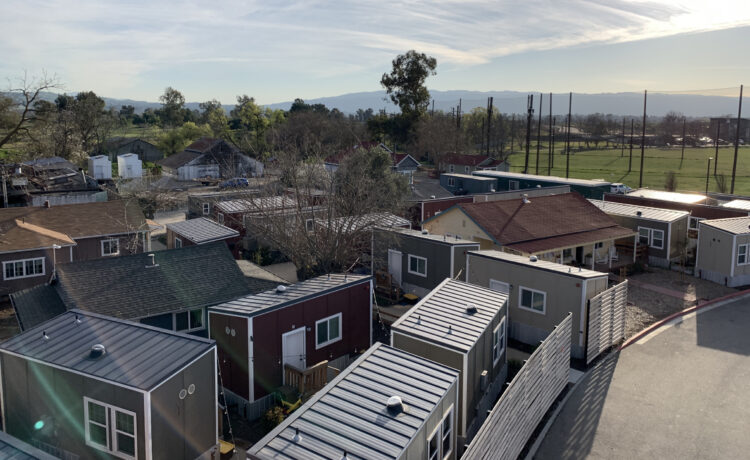In the roughly two and a half years that Goodness Village has been open, the nonprofit tiny home community has received an abundance of local support and recognition. Still, the Livermore-based organization has a number of unmet needs to sustain day-to-day operations.
Executive Director Kim Curtis told Livermore Vine in a recent interview that in addition to generally increasing awareness about the village, which provides safe and affordable living spaces to formerly unhoused people, an ongoing goal is to secure more funding for the necessary services they provide to their residents.
State Sen. Steve Glazer (D-Orinda) helped secure $5 million last year through the California Department of Social Services toward construction of a community center that is set to break ground in the new year. However, Curtis clarified that those funds are limited to being used strictly for the build and not for other aspects of the program.
Curtis acknowledged that the village has received separate grants and other funding toward its operational budget, which are helpful but mostly come in small dollar amounts that only go so far for a residential community operating 28 tiny homes.
“We may get 10 grand here, $2,500 here. Because we’re so new we’re not really eligible for those big ones that people will help position us into a much better space, so we’re building our credibility; we’re showing that we’re good stewards of money,” Curtis said. “It looks like we’re getting awarded all over the place but it’s very small dollar amounts at the same time so there’s a lot of misunderstanding about where we’re at.”
The village’s annual budget moving into 2024 is approximately $1.4 million, which includes its 24-hour wraparound mental health services, vocational program for the residents, fees paid to CrossWinds Church for using its property and wages for the Goodness Village staff, among other expenses.
Curtis stressed that Goodness Village is much more than just providing basic shelter for people. She said having four walls doesn’t automatically fix the obstacles the residents face. Providing resources for their safety, mental health, physical health and training them to re-enter the workforce are all part of the Goodness Village model.
She noted that many people also don’t realize that they are a permanent housing program and that’s what makes them unique from other similar organizations but also accounts for some of their operating costs. She said she’s faced questions about why there isn’t a time limit for rotating residents out of the village, like the 18-month cap other organizations have.
“I think it’s important that people realize there’s definitely a shortage of housing just across the United States — like seven million houses short — so that’s one thing but also just the cost of living in this area versus what their social security income is for disability and they’re pulling maybe $1,200 in a month, so where would they go?” Curtis said, adding that most of the residents are also over 50.
“Transitioning people of this population that we’re serving, we’re looking at three to five years, not 18 months and that I think is where the system is broken in what we’ve done before here, since we are the only model doing it this way,” Curtis said.
Moving people out too soon and before they are fully prepared can result in regressive behaviors that lead people back to homelessness and perpetuates a cycle that Goodness Village aims to break. “We’re really trying to hold people here for longer periods so that we can see the reasons the recidivism back to homelessness continues to happen for the chronically unsheltered,” Curtis said.
Beyond the extensive level of resources and support Goodness Village offers its residents and seeks help to fund, Curtis confirmed that the nonprofit’s plans for expansion are moving forward using the funds from Glazer. In addition to the forthcoming community center, she said they are looking to add at least 20 more homes to the community at some point.
She said that initially, they had intended for the new units and the community center to come to fruition simultaneously but those plans changed after they learned they wouldn’t be able to add units to the existing property because they would cross into the high-risk zone of the Livermore Municipal Airport.
“We really fought because we’re in a crisis and we don’t have another space to put them, but the city doesn’t want to put vulnerable people in a high-risk plane area so we’re not mad about that but now we’re trying to pivot to a Plan B,” Curtis said, adding that they are working with CrossWinds to explore what other space could be developed that could still tie into the village but not be below the airport line.
In the meantime, the houses have been pulled from the plans and the focus now is on the community center that will include a classroom, a much-needed laundry room, dining area, cooking space for micro-business opportunities and storage pantry as well as offices for staff.
As part of its fundraising efforts, Goodness Village has partnered with the Community Health & Education Foundation (CHEF) this month for a donation matching campaign where they will donate $1 (up to $10,000) for every $2 someone donates through Dec. 31.
For more information about Goodness Village and the donation campaign, visit gvlivermore.org.












